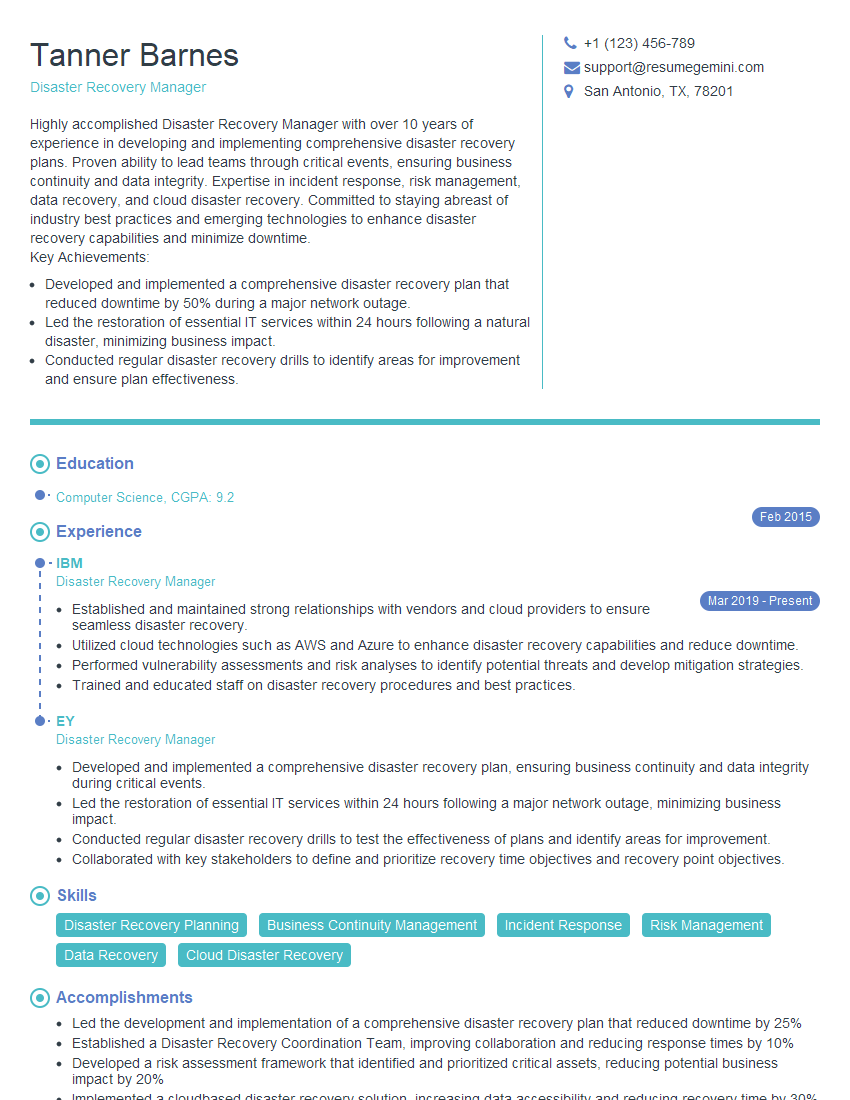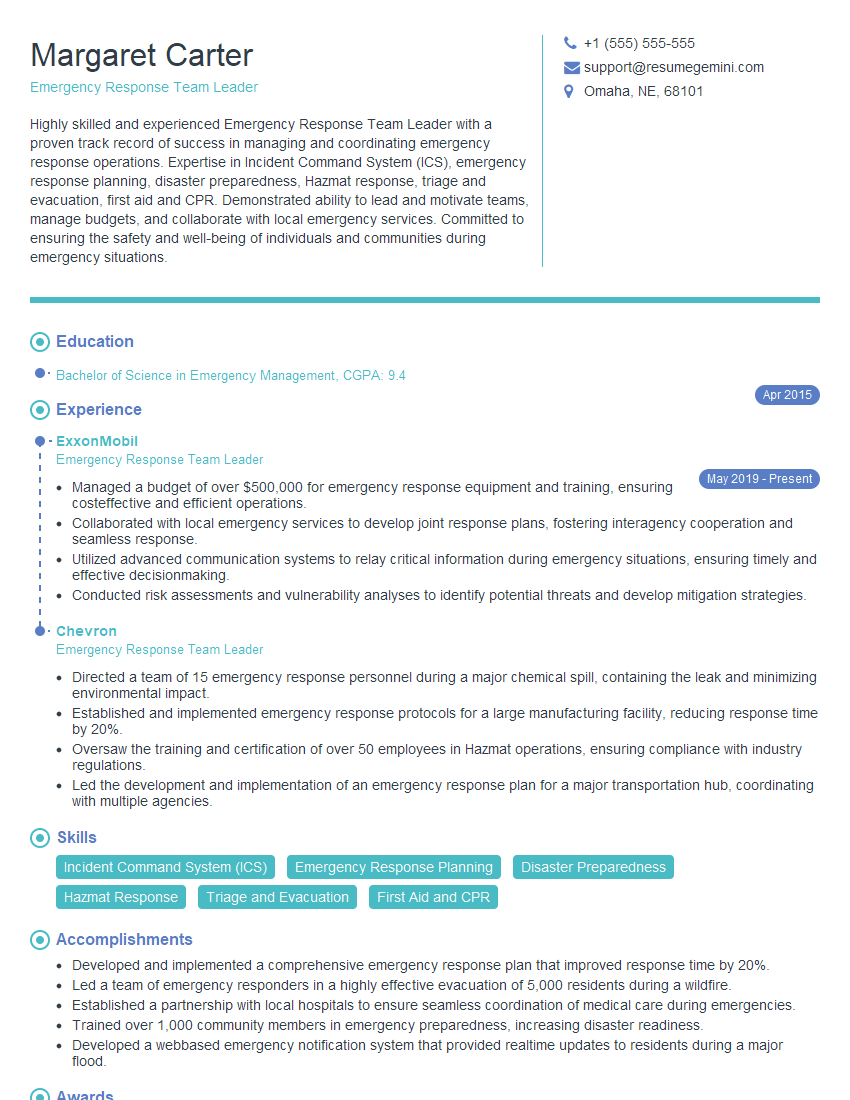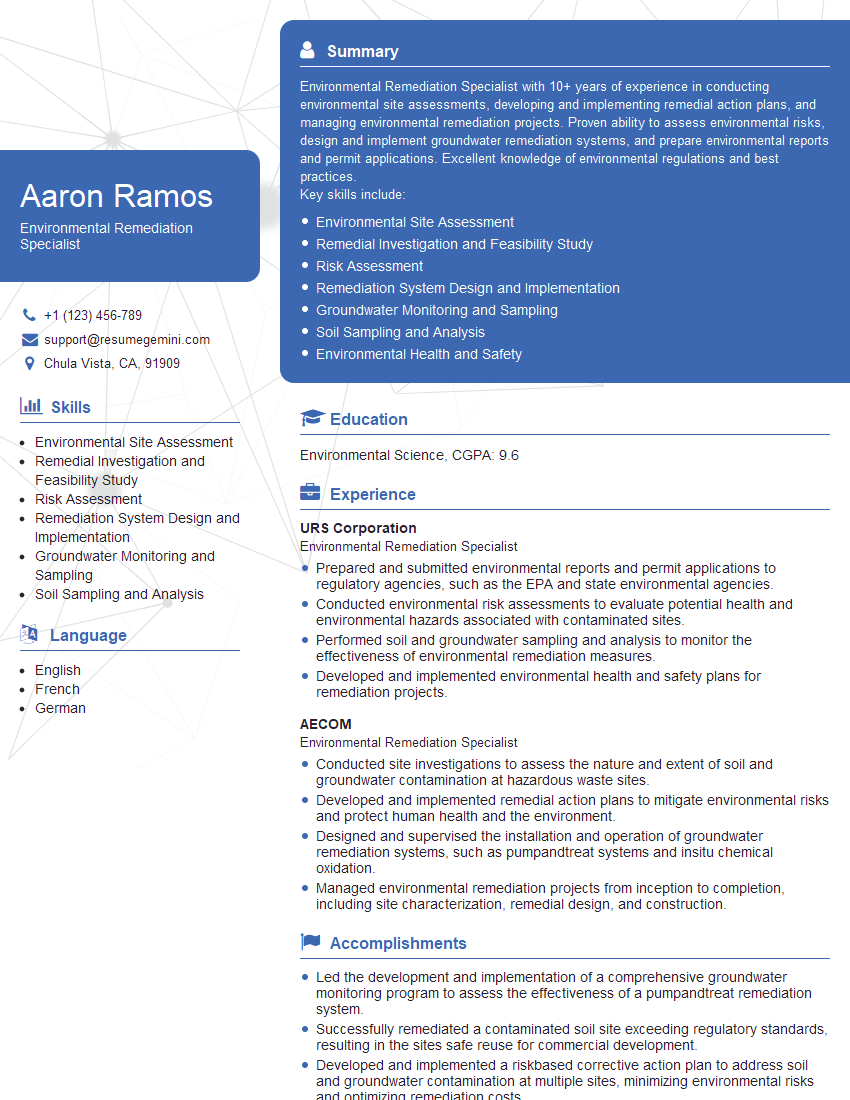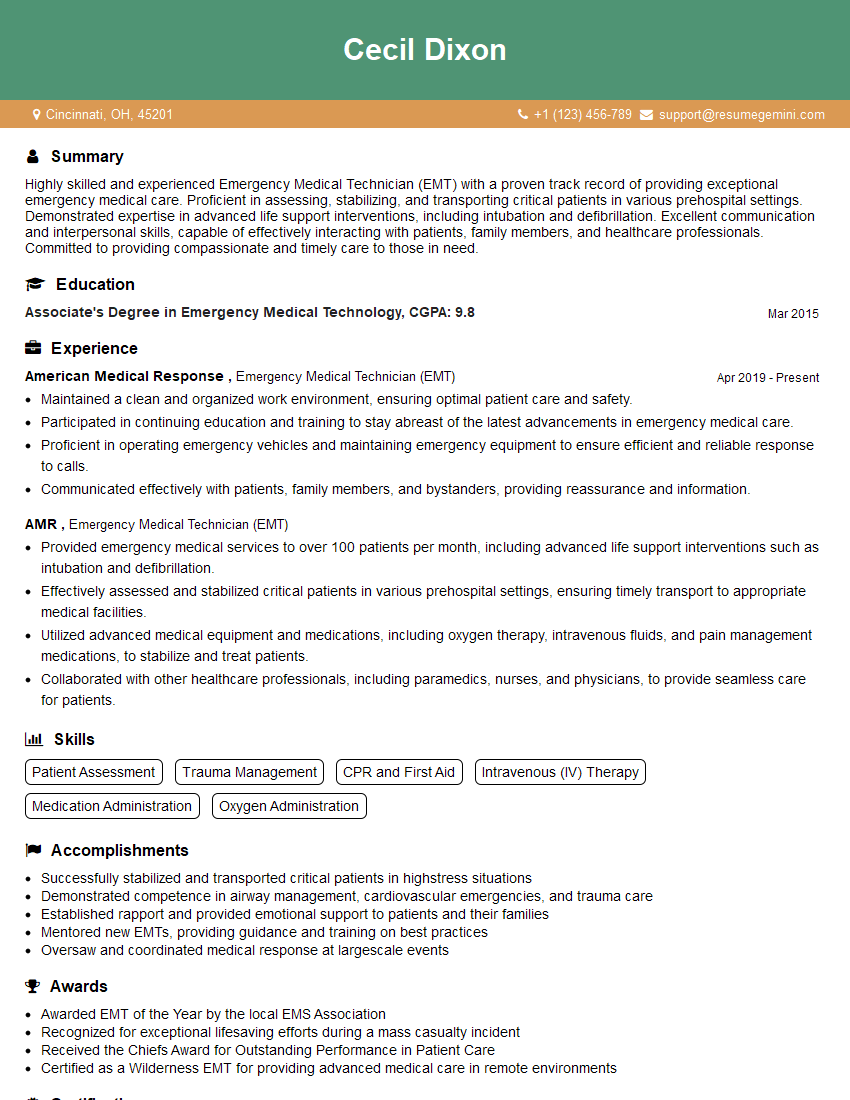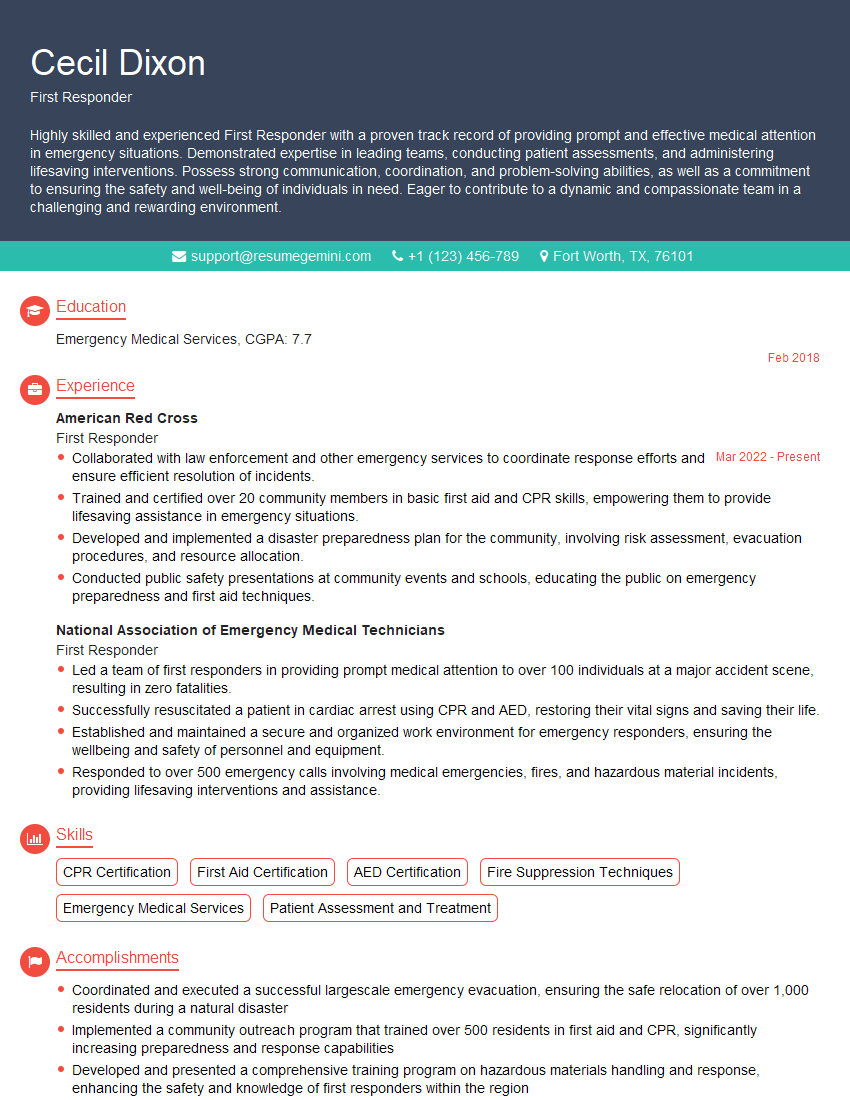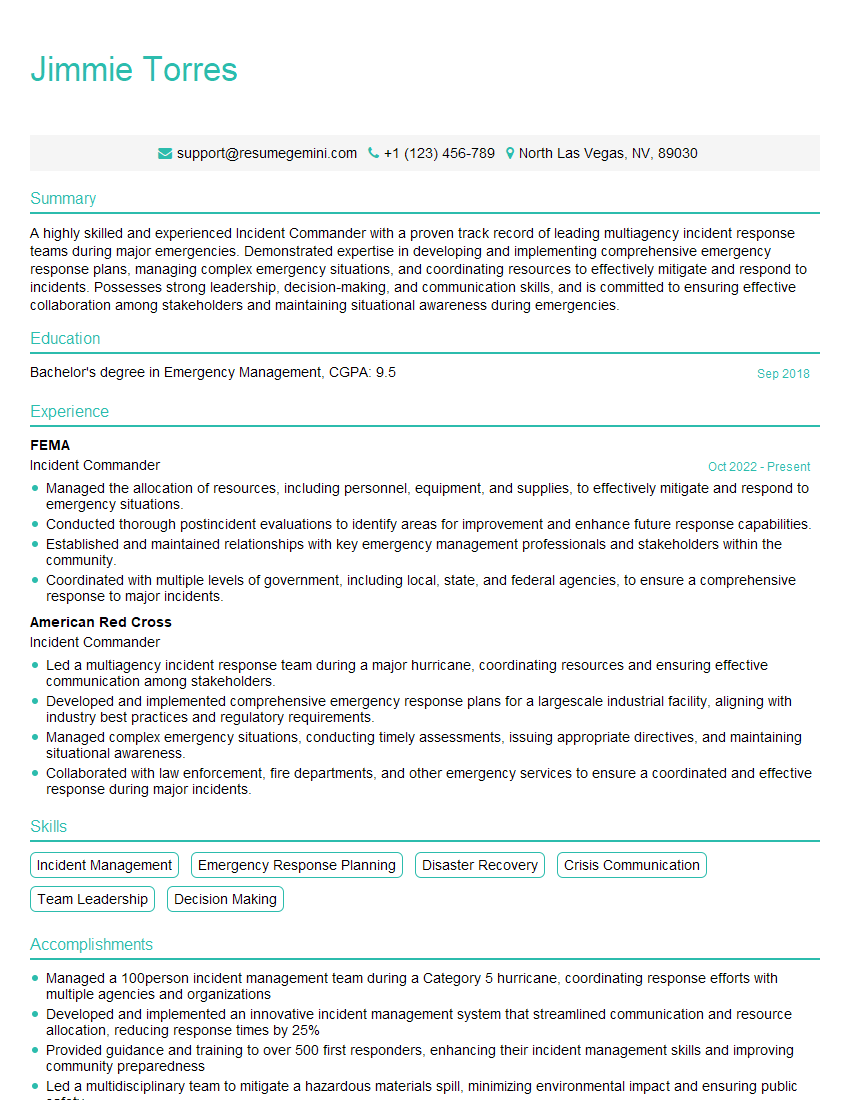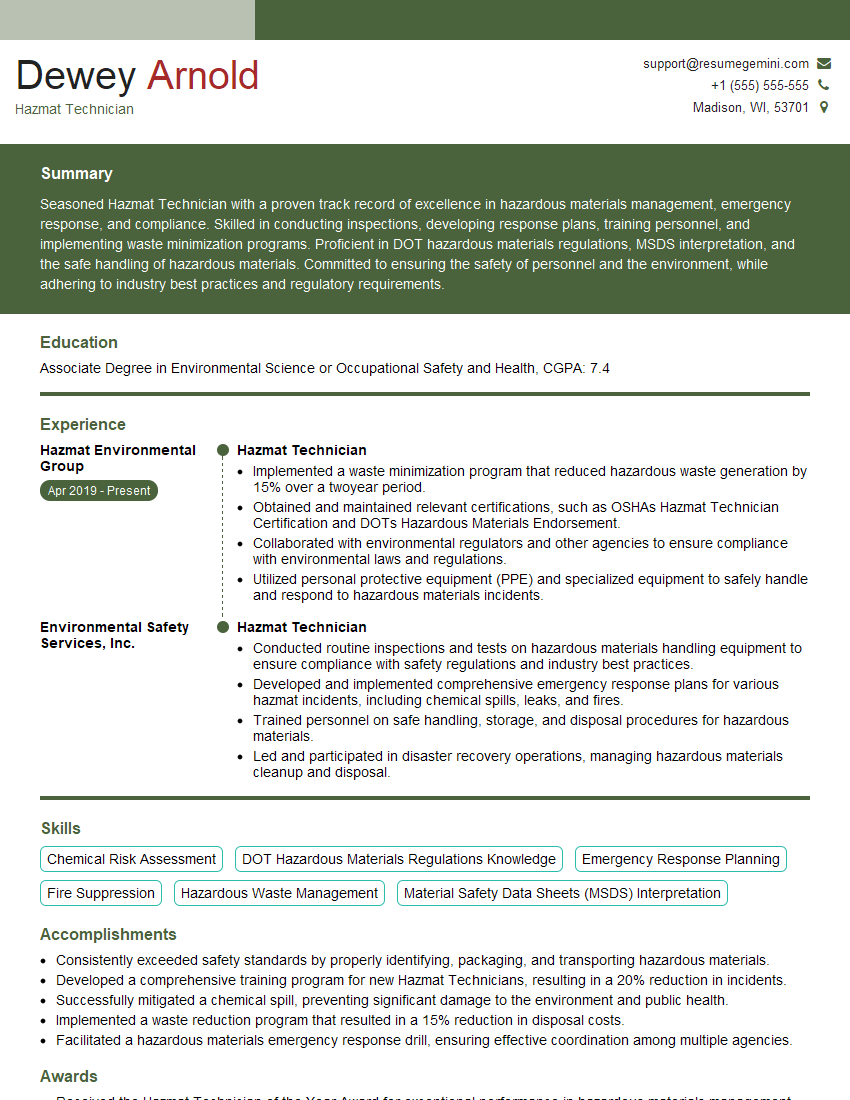Interviews are more than just a Q&A session—they’re a chance to prove your worth. This blog dives into essential Spill Response and Emergency Procedures interview questions and expert tips to help you align your answers with what hiring managers are looking for. Start preparing to shine!
Questions Asked in Spill Response and Emergency Procedures Interview
Q 1. Describe your experience with different types of spill response (oil, chemical, etc.).
My experience encompasses a wide range of spill response scenarios, from minor chemical leaks to major oil spills. I’ve been involved in incidents involving various substances, including petroleum products (crude oil, gasoline, diesel), hazardous chemicals (acids, solvents, pesticides), and even wastewater containing heavy metals. Each substance presents unique challenges due to its physical and chemical properties, influencing the choice of containment and cleanup methods. For instance, oil spills often require the use of booms and skimmers, while chemical spills may necessitate specialized absorbent materials and neutralization techniques. In one instance, I led the response to a significant chemical spill at a manufacturing plant, successfully containing the spill within hours and minimizing environmental damage through rapid deployment of absorbent booms and neutralization agents.
I have also participated in numerous training exercises simulating various spill scenarios, allowing me to refine my skills and deepen my understanding of best practices. These exercises cover diverse settings, from industrial facilities to waterways, preparing me to handle a multitude of real-world situations.
Q 2. Explain the steps involved in a typical spill response procedure.
A typical spill response procedure follows a structured approach, often remembered by the acronym ‘PLAN’: Preparation, Location, Action, Notification.
- Preparation: This involves pre-planning, training, and equipping teams with necessary personal protective equipment (PPE), tools, and materials. Having readily available emergency response kits is crucial.
- Location: Quickly and accurately assess the spill’s location, size, and the affected area. This includes identifying potential pathways for the spill to spread.
- Action: Initiate immediate containment and control measures to prevent further spread. This might involve deploying booms, using absorbent materials, or diverting the flow of the spill. Simultaneously, begin the cleanup process, utilizing appropriate methods for the spilled substance.
- Notification: Notify relevant authorities (e.g., environmental agencies, emergency services) as soon as possible, providing details about the spill and its potential impact. Accurate and timely reporting is vital to minimize environmental and health risks.
Each phase is critical, and effective coordination between responding teams is essential for a successful outcome. Imagine a scenario where a tanker truck overturns, spilling diesel fuel. Immediate action involves securing the area, preventing ignition sources, deploying booms to contain the fuel, and then notifying the appropriate authorities to coordinate cleanup and environmental monitoring.
Q 3. What are the key components of a spill response plan?
A comprehensive spill response plan is the backbone of any effective response. Key components include:
- Spill Prevention Measures: Identifying potential spill sources and implementing preventive measures to minimize the likelihood of spills occurring in the first place.
- Emergency Response Team: Establishing a trained and equipped team responsible for handling spills, including clear roles and responsibilities.
- Communication Protocols: Defining clear communication channels and procedures for internal and external notifications.
- Equipment Inventory: Maintaining a detailed inventory of all necessary equipment, including personal protective equipment (PPE), containment and cleanup materials, and transportation vehicles.
- Emergency Contact List: A readily accessible list of emergency contacts for relevant authorities, contractors, and personnel.
- Cleanup Procedures: Specific procedures outlining appropriate methods for cleanup based on different spill types, including disposal of contaminated materials.
- Training and Drills: Regular training and drills to ensure the emergency response team is prepared to handle real-world scenarios.
- Post-Spill Procedures: Procedures for post-spill activities, including environmental monitoring, investigation of the cause, and reporting to regulatory authorities.
Think of it like a fire evacuation plan – you hope you never need it, but having a robust, well-rehearsed plan is vital for a swift and effective response should an incident occur.
Q 4. How do you assess the severity of a spill and prioritize response actions?
Assessing spill severity involves considering several factors: the type and quantity of spilled material, the location of the spill (e.g., proximity to water sources, sensitive ecosystems), and the potential environmental and health impacts. A framework for prioritizing response actions might include a matrix considering:
- Toxicity/Hazard Level: Highly toxic substances require immediate and intensive response.
- Volume/Spread: Larger spills generally require more resources and a faster response.
- Environmental Sensitivity: Spills near vulnerable ecosystems (wetlands, endangered species habitats) need immediate action.
- Potential for Secondary Impacts: Considering factors such as potential for explosion, fire, or waterway contamination.
Prioritization often uses a weighted scoring system, allowing for a rational decision-making process. For example, a small spill of a highly toxic chemical near a drinking water source would be prioritized higher than a large spill of a less toxic substance in a remote, unpopulated area. This process ensures resources are allocated efficiently and effectively.
Q 5. What are the common regulatory requirements for spill reporting and cleanup?
Regulatory requirements for spill reporting and cleanup vary significantly depending on the location, the type and quantity of spilled material, and the potential environmental impact. However, common elements often include:
- Immediate Notification: Prompt reporting to relevant authorities (e.g., environmental protection agencies, coast guard) within a specified timeframe (often hours).
- Detailed Reporting: Providing comprehensive information about the spill, including the substance involved, the quantity spilled, the location, and the potential environmental impact.
- Cleanup and Remediation: Compliance with regulations regarding cleanup methods, waste disposal, and restoration of the affected area.
- Record Keeping: Maintaining detailed records of the spill incident, cleanup efforts, and any follow-up actions.
- Penalties for Non-Compliance: Significant fines and legal penalties can result from failure to comply with reporting and cleanup requirements.
Understanding these regulations is crucial, as non-compliance can result in substantial penalties and legal ramifications. Each organization handling hazardous materials needs to be thoroughly familiar with the relevant regulations in their operating area.
Q 6. Describe your experience with containment and recovery methods for various spills.
Containment and recovery methods are highly dependent on the nature of the spill.
- Oil Spills: Booms (floating barriers) are used to contain the spread of oil on water surfaces. Skimmers are then used to remove the oil from the water. Absorbent materials (e.g., pads, booms) are used for smaller spills or in shoreline cleanup.
- Chemical Spills: Containment methods might include dikes, dams, or absorbent materials, depending on the properties of the chemical. Recovery methods may include vacuum trucks, absorbent materials, and neutralization techniques. The choice depends on factors like solubility and reactivity.
- Hazardous Materials Spills: These often require specialized equipment and procedures, following strict safety protocols. Specialized teams with expertise in handling specific hazardous substances are frequently involved.
I’ve personally used various methods, from deploying booms in a river to using vacuum trucks to remove solvents from a warehouse floor. Each situation requires a tailored approach, emphasizing safety and environmental protection. For example, in a recent incident involving a solvent spill in a confined space, we employed specialized vacuum trucks and utilized proper ventilation to ensure the safety of the response team while minimizing exposure to dangerous fumes.
Q 7. How do you ensure the safety of personnel during a spill response operation?
Ensuring personnel safety during a spill response is paramount. This involves a multi-layered approach:
- Proper Training: Thorough training in handling hazardous materials, using specialized equipment, and adhering to safety protocols is essential. This includes regular refreshers and simulations.
- Personal Protective Equipment (PPE): Providing appropriate PPE, such as respirators, gloves, protective suits, and eye protection, based on the hazards present is non-negotiable.
- Hazard Assessment: Conducting a thorough hazard assessment before commencing any response activities to identify potential risks and develop appropriate safety measures.
- Emergency Communication: Establishing clear communication systems and procedures to facilitate rapid response and coordination in case of emergencies.
- Medical Surveillance: Providing access to medical personnel and conducting regular health checks for personnel involved in spill response.
- Decontamination Procedures: Implementing thorough decontamination procedures for personnel after exposure to hazardous materials.
Safety is never compromised. Think of it as a safety net – multiple layers of protection to minimize risks to personnel responding to a hazardous situation.
Q 8. What types of personal protective equipment (PPE) are used in spill response?
Personal Protective Equipment (PPE) is crucial in spill response to safeguard responders from hazardous materials. The specific PPE used depends heavily on the nature of the spilled substance. For example, a chemical spill might require vastly different PPE than an oil spill.
- Respiratory Protection: This is often the most critical aspect. It can range from simple dust masks for less hazardous spills to self-contained breathing apparatus (SCBA) for highly toxic or oxygen-deficient environments. The choice depends on the substance’s toxicity and the concentration in the air.
- Eye Protection: Chemical splash goggles or face shields are essential to prevent eye injury from splashes or aerosols. The level of protection required depends on the corrosiveness or irritancy of the spilled material.
- Skin Protection: This usually involves chemical-resistant suits, gloves, and boots. The material of the protective clothing (e.g., nitrile, neoprene, butyl rubber) is chosen based on the spilled substance’s compatibility. For example, nitrile gloves might suffice for a mild oil spill, but a more robust material like butyl rubber might be needed for strong acids or solvents.
- Other Protective Gear: Depending on the situation, additional PPE might include hard hats, safety shoes with steel toes, and protective aprons.
For instance, during a response to a sulfuric acid spill, responders would utilize SCBA, fully encapsulating chemical-resistant suits, and heavy-duty boots to prevent any skin or respiratory contact. A less hazardous spill, like a small quantity of vegetable oil, might only necessitate gloves and absorbent pads.
Q 9. How do you manage communication and coordination during a large-scale spill event?
Effective communication and coordination are paramount during a large-scale spill. Think of it as orchestrating a complex symphony – everyone needs to play their part in harmony. We utilize a multi-faceted approach:
- Incident Command System (ICS): This standardized, on-scene management system ensures clear roles, responsibilities, and communication channels. It establishes a chain of command and facilitates efficient resource allocation.
- Communication Technologies: Radios, cell phones, and satellite phones are essential for real-time updates between teams on-site and off-site personnel. We also utilize dedicated communication channels to avoid congestion and maintain clarity.
- Incident Action Plan (IAP): This document outlines the overall strategy, objectives, and assignments for each team. Regular updates to the IAP help in adapting to changing circumstances during the incident.
- Regular Briefings: Frequent briefings are held to keep everyone informed of the latest developments, coordinate actions, and address any emerging issues. These might involve daily, hourly, or even more frequent updates, depending on the severity and evolution of the incident.
- Liaison Officers: We designate liaison officers to communicate with external stakeholders, such as government agencies, the media, and the affected community. Transparent communication is essential to manage public perception and concerns.
During a major oil spill I worked on, our ICS structure was instrumental in coordinating the deployment of booms, skimmers, and cleanup crews. Regular briefings kept everyone informed about the changing tide and wind conditions, enabling us to adjust our strategy accordingly.
Q 10. What is your experience with using specialized equipment (e.g., booms, skimmers, vacuums)?
My experience with specialized spill response equipment is extensive. I’ve worked extensively with various types of equipment to address a wide array of spills.
- Booms: These floating barriers contain and prevent the spread of spilled liquids on water. I have experience deploying various types, including sorbent booms (which absorb the spill) and containment booms (which simply block the spread).
- Skimmers: These are used to remove oil or other liquids from the water’s surface. I’m proficient in operating several types, including weir skimmers, belt skimmers, and vacuum skimmers, selecting the best option based on the spill’s viscosity and volume.
- Vacuum Trucks: These are used for collecting liquids from land spills, typically employing specialized nozzles and hoses for effective suction and transfer.
- Absorbents: These materials, such as pads, booms, pillows, and socks, absorb spilled liquids. The choice of absorbent depends on the spill type and environmental conditions.
For example, in one incident involving a large oil spill in a river, I oversaw the strategic deployment of containment booms to prevent further downstream spread, followed by the efficient use of several skimmers working in tandem to remove the floating oil. We then used absorbent pads to mop up residual oil from the shoreline.
Q 11. How do you determine the appropriate cleanup methods for different types of spills?
Choosing the right cleanup method depends heavily on several factors: the type of spilled substance, the volume of the spill, the location of the spill (land, water, etc.), environmental sensitivity, and weather conditions.
- Hazardous Materials: Spills involving hazardous materials (e.g., chemicals, solvents) necessitate specialized cleanup procedures, often requiring trained personnel and specialized equipment. This may include neutralization, containment, and disposal in accordance with relevant regulations.
- Oil Spills: Oil spill cleanup methods range from simple absorbent materials for small spills to sophisticated techniques involving skimmers, booms, and bioremediation for larger spills. The viscosity and type of oil influence the choice of techniques.
- Water-Soluble Substances: Water-soluble substances often require different approaches, such as dilution, flushing, or filtration. The impact on water quality is a key consideration.
- Solid Waste: Solid waste spills usually involve manual collection and disposal, often following hazardous waste protocols if appropriate.
For instance, a small gasoline spill on a paved area might only require absorbent pads and careful disposal of the contaminated material. However, a large chemical spill into a sensitive wetland would require a much more comprehensive response, potentially involving multiple agencies, specialized equipment, and extensive environmental monitoring.
Q 12. Describe your experience with environmental impact assessments after a spill.
Post-spill environmental impact assessments are critical for evaluating the extent of damage and guiding remediation efforts. My experience involves a systematic approach:
- Data Collection: This involves gathering data on the type and volume of spilled substance, affected areas, and potential environmental receptors (e.g., water bodies, soil, wildlife).
- Sampling and Analysis: We collect samples of soil, water, and potentially affected organisms for laboratory analysis to quantify contamination levels.
- Ecological Surveys: These surveys assess the impacts on flora and fauna, identifying any mortality or habitat damage.
- Modeling and Prediction: We may utilize computer models to predict the long-term fate and transport of the spilled substance, guiding our remediation strategies.
- Report Preparation: The findings are compiled into a comprehensive report outlining the extent of damage, potential long-term impacts, and recommended remediation measures.
In one case, a significant chemical spill into a river required extensive sampling and analysis to assess the extent of water contamination. The results of these assessments guided the development of a remediation plan, including water treatment and habitat restoration.
Q 13. How do you handle unexpected challenges or complications during a spill response?
Spill response is inherently unpredictable; unexpected challenges are commonplace. Our approach emphasizes adaptability and preparedness:
- Contingency Planning: We develop detailed contingency plans that address potential complications, such as equipment failure, adverse weather conditions, or unexpected substance interactions.
- Risk Assessment: A thorough risk assessment identifies potential hazards and vulnerabilities, helping us proactively mitigate risks.
- Flexible Response: The ability to adapt to changing circumstances is crucial. This requires effective communication, coordination, and a willingness to adjust the response strategy based on new information.
- Expert Consultation: In complex scenarios, we consult with specialists (e.g., toxicologists, hydrologists) to get expert advice and guidance.
For example, during an oil spill, unexpected strong winds could shift the oil slick rapidly. Our team’s ability to quickly adapt the boom deployment strategy, based on real-time wind forecasts, proved vital in preventing widespread environmental damage.
Q 14. What is your experience with emergency planning and training?
Emergency planning and training are fundamental to effective spill response. My experience covers a wide range of activities:
- Developing Emergency Response Plans: I’ve participated in creating comprehensive emergency response plans for various facilities and industries, ensuring compliance with relevant regulations and best practices.
- Conducting Drills and Exercises: Regular drills and exercises are crucial for testing response capabilities and identifying weaknesses. I’ve led numerous full-scale spill response simulations, involving multiple agencies and stakeholders.
- Training Personnel: I’ve provided training to personnel on various aspects of spill response, including PPE usage, equipment operation, safety protocols, and incident command procedures.
- Developing Training Materials: I’ve helped create training manuals, presentations, and videos to support spill response training initiatives.
One example of my work involved designing and implementing a comprehensive emergency response training program for a chemical manufacturing plant. This program included scenario-based exercises, equipment familiarization, and classroom instruction, significantly enhancing the plant’s preparedness for potential spills.
Q 15. Explain your understanding of hazardous materials identification and classification.
Hazardous materials identification and classification is crucial for effective spill response. It involves accurately determining the nature of the spilled substance and understanding its inherent dangers. This process uses various systems, most notably the Globally Harmonized System of Classification and Labelling of Chemicals (GHS). The GHS uses hazard pictograms, signal words (danger or warning), hazard statements, and precautionary statements to communicate the risks associated with a chemical.
For example, a spill of corrosive material like sulfuric acid would be identified by its chemical name and then classified according to its corrosive properties, indicated by a specific pictogram (a corrosive symbol) and hazard statements outlining its potential to cause skin burns and eye damage. This information is critical for selecting the appropriate personal protective equipment (PPE), choosing the right containment and cleanup methods, and notifying the relevant authorities.
Beyond the GHS, other classification systems exist depending on the type of material and regulatory requirements. Transportation regulations, for instance, utilize a different classification system with specific labels and requirements for safe handling and transportation. Understanding these systems is paramount to ensure safety and compliance.
Career Expert Tips:
- Ace those interviews! Prepare effectively by reviewing the Top 50 Most Common Interview Questions on ResumeGemini.
- Navigate your job search with confidence! Explore a wide range of Career Tips on ResumeGemini. Learn about common challenges and recommendations to overcome them.
- Craft the perfect resume! Master the Art of Resume Writing with ResumeGemini’s guide. Showcase your unique qualifications and achievements effectively.
- Don’t miss out on holiday savings! Build your dream resume with ResumeGemini’s ATS optimized templates.
Q 16. Describe your experience with incident reporting and documentation.
Incident reporting and documentation are the cornerstones of accountability and continuous improvement in spill response. My experience involves meticulous record-keeping, starting from the initial notification of the spill. This includes documenting the time, location, type and quantity of the spilled material, weather conditions, and any immediate observable effects. I utilize standardized forms and digital reporting systems to ensure consistency and accuracy.
Detailed descriptions of the response actions taken, including personnel involved, equipment used, and specific cleanup methods employed, are meticulously documented. This includes any photos or videos taken on the site. Environmental monitoring data, remediation efforts, and post-spill assessment reports are also integrated into the comprehensive documentation package. This ensures compliance with regulatory requirements and provides valuable data for future risk assessments and training exercises.
In one instance, I was the lead on a significant chemical spill. The detailed reporting process we followed not only ensured efficient cleanup but also facilitated a thorough investigation into the root cause of the incident, allowing for implementation of preventive measures and ultimately preventing future occurrences.
Q 17. How do you ensure compliance with environmental regulations during cleanup?
Ensuring compliance with environmental regulations during cleanup is paramount. This involves a multifaceted approach that begins with identifying the applicable laws and regulations at the federal, state, and local levels. These regulations often define permissible exposure limits, reporting thresholds, and cleanup standards for specific pollutants.
Prior to commencing any cleanup operation, a detailed site assessment is conducted to determine the extent of contamination and the potential environmental impact. This information is then used to develop a comprehensive cleanup plan that adheres to all applicable regulations. This plan includes procedures for containing the spill, protecting sensitive ecosystems, and disposing of contaminated materials appropriately. Regular monitoring of air, water, and soil is conducted throughout the cleanup to verify the effectiveness of the remediation efforts and ensure that regulatory limits are met.
For example, when dealing with a petroleum spill near a waterway, we’d be mindful of the Clean Water Act and other relevant regulations, ensuring that our containment and cleanup techniques minimized environmental damage and met all discharge standards. Proper documentation of all actions taken is crucial for demonstrating compliance to regulatory agencies.
Q 18. What is your experience with post-spill monitoring and remediation?
Post-spill monitoring and remediation are critical for ensuring the long-term environmental safety and restoring the affected area. This phase typically involves continued monitoring of environmental parameters, such as soil and water quality, to assess the effectiveness of the initial cleanup efforts. If residual contamination is detected, further remediation actions may be necessary. This could involve excavation and removal of contaminated soil, bioremediation (using microorganisms to break down pollutants), or other specialized techniques.
Detailed data analysis is integral to this process. We use statistical methods to evaluate the effectiveness of the remediation strategies and determine if further action is needed to achieve regulatory compliance and minimize long-term environmental impacts. The monitoring period usually lasts several months or even years depending on the nature and extent of the contamination.
I’ve been involved in several projects where post-spill monitoring revealed unexpected contamination requiring additional remediation steps. This highlighted the importance of comprehensive and ongoing monitoring, ensuring that the affected area is fully restored to its pre-spill condition.
Q 19. Describe your experience with working in a team environment during a crisis.
Working effectively in a team environment during a crisis is essential for a successful spill response. My experience highlights the importance of clear communication, defined roles, and collaborative decision-making. Effective communication is paramount, ensuring everyone understands their responsibilities and can efficiently share information. We utilize established communication protocols, including radio systems, emergency response software and even simple visual aids.
Clear roles and responsibilities are pre-defined within the response team, designating individuals as incident commanders, safety officers, environmental specialists, and others based on their expertise. This structure promotes efficiency and coordination during the crisis. Collaborative decision-making is vital, bringing diverse perspectives and expertise to bear on the challenging situations presented by a spill. This team approach fosters a culture of mutual support and shared responsibility.
During a major oil spill, for instance, I worked as part of a team comprised of environmental scientists, engineers, cleanup crews, and government officials. Our success depended on the seamless coordination of efforts and the collective understanding of the immediate priorities – containing the spill, protecting the environment, and ensuring personnel safety.
Q 20. How do you make critical decisions under pressure?
Making critical decisions under pressure requires a combination of training, experience, and a structured approach. My approach involves a systematic process: first, I assess the situation by gathering all available information quickly and accurately. Then, I identify the key challenges and potential risks, prioritizing the most urgent tasks. I involve my team in the decision-making process, leveraging their expertise to ensure the best course of action is chosen.
Risk assessment is a core component of my decision-making under pressure. I use decision-making frameworks, weighing the potential consequences of each option against the available resources and time constraints. Communication remains paramount throughout the process, keeping the team informed and coordinating actions.
During a large chemical spill, I had to rapidly decide whether to use a particular containment method despite some uncertainty about its complete efficacy. I used a risk matrix to assess the alternatives and weighed the potential environmental risks against the delay in using a more tested, but slower approach. The decision, made under significant time pressure, proved successful, largely due to the careful consideration of all the variables.
Q 21. What are your skills in risk assessment and mitigation?
Risk assessment and mitigation are fundamental aspects of spill response. My skills encompass identifying potential hazards, assessing their likelihood and potential consequences, and developing strategies to mitigate or eliminate these risks. This involves considering various factors, including the type and quantity of hazardous materials, environmental conditions, potential pathways of exposure, and vulnerable populations.
I use both qualitative and quantitative methods for risk assessment. Qualitative methods involve expert judgment and experience to evaluate risk levels, while quantitative methods utilize mathematical models and data analysis to assign probabilities and consequences to potential hazards. The outputs from these assessments inform the development of mitigation strategies, which might include engineering controls (e.g., containment barriers), administrative controls (e.g., safety protocols), and personal protective equipment (PPE).
For example, when assessing the risk of a chemical spill at an industrial facility, I’d analyze historical data, review safety procedures, and conduct a site inspection to identify potential failure points and vulnerabilities. This would be followed by a detailed risk assessment report that provides recommendations to reduce the likelihood and severity of a spill, including enhanced safety training, regular equipment inspections, and the implementation of emergency response procedures.
Q 22. Describe your experience with different types of spill prevention measures.
Spill prevention is paramount, and my experience encompasses a wide range of measures, from engineering controls to administrative practices. Engineering controls focus on preventing spills at their source. This includes things like implementing secondary containment systems – think of the berms around storage tanks that prevent spills from spreading. We also utilize leak detection systems, often employing sensors that trigger alarms if a leak is detected. Regular inspections and maintenance of equipment are critical, catching potential problems before they become spills. For example, I’ve overseen the implementation of a regular valve inspection program at a refinery that identified and addressed several minor leaks, preventing a much larger spill. Administrative controls complement the engineering aspects. This includes thorough training programs for personnel handling hazardous materials, establishing strict operating procedures, and implementing robust spill reporting protocols. I’ve developed and implemented such a program, resulting in a significant reduction in minor incidents at a chemical manufacturing plant.
- Secondary Containment: Using berms, dikes, or sumps to contain spills.
- Leak Detection Systems: Utilizing sensors and automated alarms.
- Regular Inspections & Maintenance: Preventative maintenance to identify and fix potential problems.
- Training Programs: Educating employees on proper handling and emergency response.
- Operating Procedures: Clear, concise instructions for handling hazardous materials.
- Spill Reporting: A system for promptly reporting spills of all sizes.
Q 23. How do you utilize data and analysis to inform your spill response decisions?
Data and analysis are the backbone of effective spill response. Before, during, and after a spill, we collect a wide array of data. This includes the type and quantity of spilled material, weather conditions (wind speed and direction are crucial), topography of the affected area, and water currents if the spill involves a waterway. We use Geographic Information Systems (GIS) to map the spill, predicting its spread. For instance, if a chemical spill occurs near a river, GIS allows us to model the plume’s movement downstream, identifying areas at risk and prioritizing cleanup efforts. We also analyze historical spill data to identify trends and vulnerabilities. This might reveal that a particular type of equipment is prone to leaks, leading to preventative maintenance protocols. Statistical analysis can help us assess the effectiveness of different response techniques. For example, I once used statistical modeling to compare the efficacy of different absorbent materials in a large oil spill, leading to cost savings and improved environmental outcomes.
Q 24. What are the key considerations for selecting a spill response contractor?
Selecting a competent spill response contractor is crucial. I prioritize contractors with proven experience, appropriate certifications (like those from organizations like the Institute of Hazardous Materials Management), and a strong safety record. Their equipment needs to be suitable for the type of spill anticipated; a contractor specializing in oil spills might not be the best choice for a chemical spill. Financial stability is also key, ensuring they can handle the demands of a large-scale incident. I always verify their insurance coverage, including liability insurance and workers’ compensation. Finally, I review their emergency response plan and their ability to communicate effectively during an emergency. I’ve seen situations where poor communication between the contractor and the responsible party hampered response efforts, resulting in extended cleanup times and increased environmental damage.
Q 25. Describe your experience with managing budgets and resources during a spill response.
Budget management during a spill response is a delicate balance between efficiency and effectiveness. Initially, we assess the likely costs based on the spill’s size and complexity. This involves estimating the cost of labor, equipment rental, disposal of contaminated materials, and potential environmental remediation. We establish a contingency fund to cover unforeseen expenses, such as specialized equipment or extended cleanup time. Throughout the response, we monitor expenses closely, ensuring that funds are spent efficiently without compromising the effectiveness of the cleanup. We use project management software to track expenses and allocate resources. For instance, during a large-scale chemical spill, I utilized a project management system to track hourly labor costs, material expenses, and equipment rentals, enabling me to stay within budget while ensuring a rapid and effective response.
Q 26. How do you ensure the effectiveness of your spill response training programs?
Effective spill response training is crucial. Our programs are built around realistic scenarios and hands-on exercises. We use a blended learning approach combining classroom instruction, online modules, and field training. We utilize simulated spills, allowing personnel to practice using equipment and coordinating their response. The training incorporates regular assessments and drills to evaluate understanding and retention of key concepts. After training, we conduct regular refresher courses and evaluate the program’s effectiveness by tracking employee performance during actual incidents. We also incorporate feedback from employees to continuously improve the training program. For example, after a recent training exercise, employee feedback led to improvements in our equipment deployment procedures, making our response significantly more efficient.
Q 27. Explain your understanding of the legal liabilities associated with spills.
Legal liabilities associated with spills are significant and complex. They vary depending on factors such as the type and quantity of spilled material, the extent of environmental damage, and compliance with regulations. Key legislation includes the Clean Water Act (CWA) and the Comprehensive Environmental Response, Compensation, and Liability Act (CERCLA), better known as Superfund. Violations can lead to substantial fines, legal action from affected parties, and even criminal charges. Responsible parties face liabilities for cleanup costs, damages to natural resources, and potential health impacts on individuals. Thorough documentation of the spill, response efforts, and all associated costs is critical for managing legal liabilities. A clear chain of custody for all samples taken is also vital. I’ve worked with legal teams to navigate the complexities of these regulations ensuring the client’s compliance and minimizing their legal exposure.
Q 28. How do you stay updated on the latest best practices and regulations in spill response?
Staying current in this dynamic field requires continuous professional development. I actively participate in industry conferences and workshops, attending sessions on the latest response techniques and regulatory updates. I subscribe to professional journals and online resources, keeping abreast of new technologies and best practices. I also maintain close relationships with regulatory agencies, ensuring our response plans align with the latest regulations. Networking with other professionals in the field is equally vital; sharing experiences and lessons learned is a great way to stay ahead of the curve. For instance, I recently attended a workshop on the use of drones in spill response, leading to the incorporation of this technology into our response strategy.
Key Topics to Learn for Spill Response and Emergency Procedures Interview
- Spill Classification and Prioritization: Understanding different types of spills (oil, chemical, etc.), their environmental impact, and the urgency of response based on severity and potential consequences.
- Emergency Response Plans (ERPs): Knowing how to interpret and implement ERPs, including familiarization with site-specific plans and emergency contact procedures. Practical application includes demonstrating understanding of roles and responsibilities within a response team.
- Containment and Control Techniques: This includes theoretical knowledge of booms, sorbents, skimmers, and other containment equipment, and practical understanding of their application based on spill type and environmental conditions. Consider scenarios involving different terrains and weather.
- Cleanup and Remediation Methods: Understanding the various cleanup techniques, their effectiveness, and the importance of environmental regulations and best practices. This includes understanding the long-term effects of spills and the importance of proper remediation.
- Safety Procedures and Personal Protective Equipment (PPE): Deep understanding of safety protocols, hazard identification, risk assessment, and the correct use of PPE in diverse spill scenarios. Practical application involves knowing appropriate PPE for different substances and situations.
- Regulatory Compliance and Reporting: Understanding relevant legislation, reporting procedures to regulatory bodies (e.g., Coast Guard, EPA), and the importance of accurate documentation and record-keeping.
- Communication and Teamwork: Effective communication strategies during emergencies, collaboration with different teams (first responders, environmental agencies), and the importance of clear and concise reporting.
- Incident Investigation and Root Cause Analysis: Understanding the process of investigating spill incidents, identifying contributing factors, and implementing preventative measures to avoid future occurrences.
Next Steps
Mastering Spill Response and Emergency Procedures is crucial for career advancement in the environmental and safety sectors. It demonstrates a commitment to safety, environmental protection, and efficient crisis management—highly valued skills in today’s job market. To maximize your job prospects, creating a strong, ATS-friendly resume is vital. ResumeGemini is a trusted resource to help you build a professional and effective resume that highlights your skills and experience in this field. Examples of resumes tailored to Spill Response and Emergency Procedures are available to guide you. Invest the time to craft a compelling resume – it’s your first impression on potential employers.
Explore more articles
Users Rating of Our Blogs
Share Your Experience
We value your feedback! Please rate our content and share your thoughts (optional).
What Readers Say About Our Blog
good
